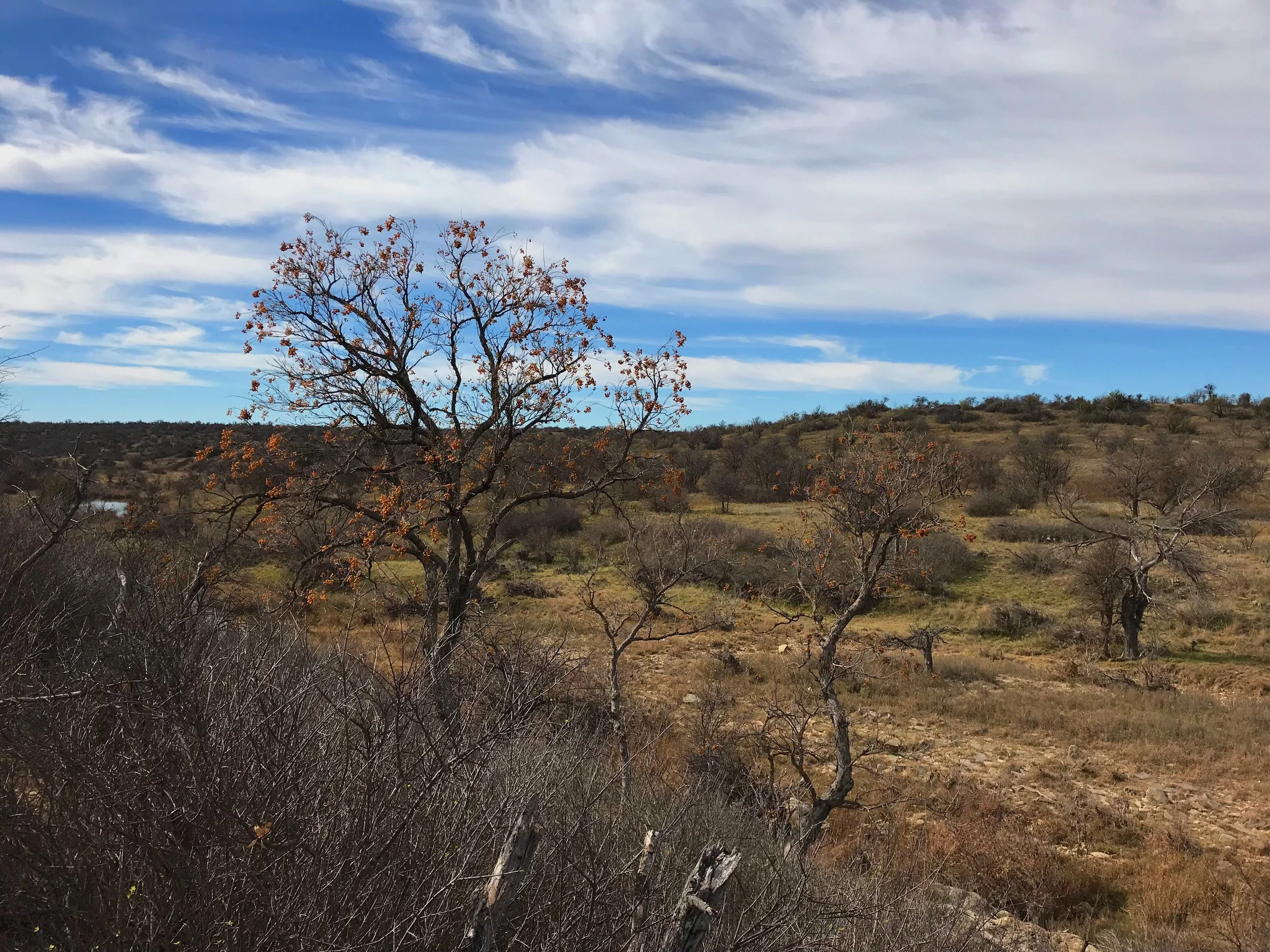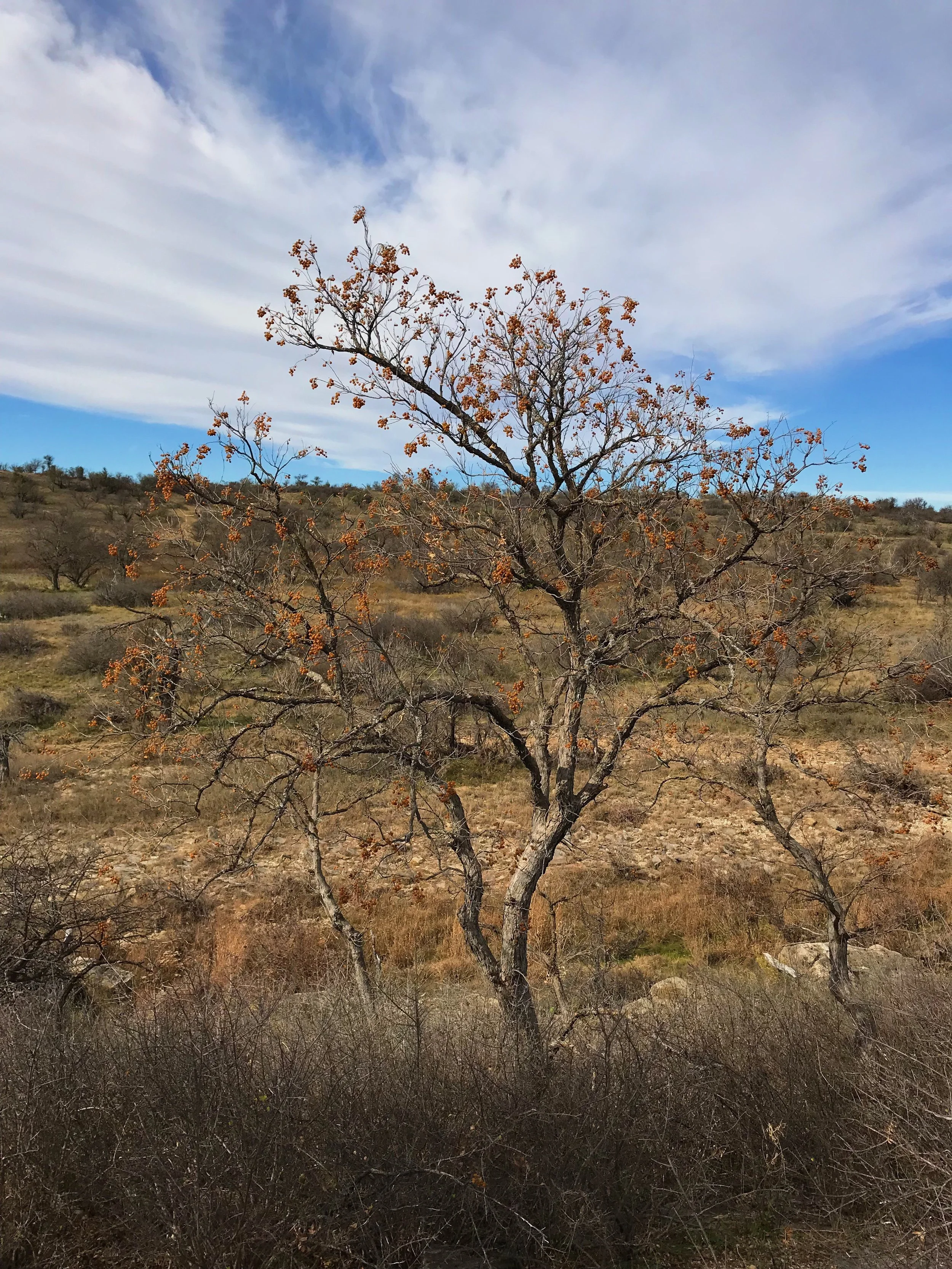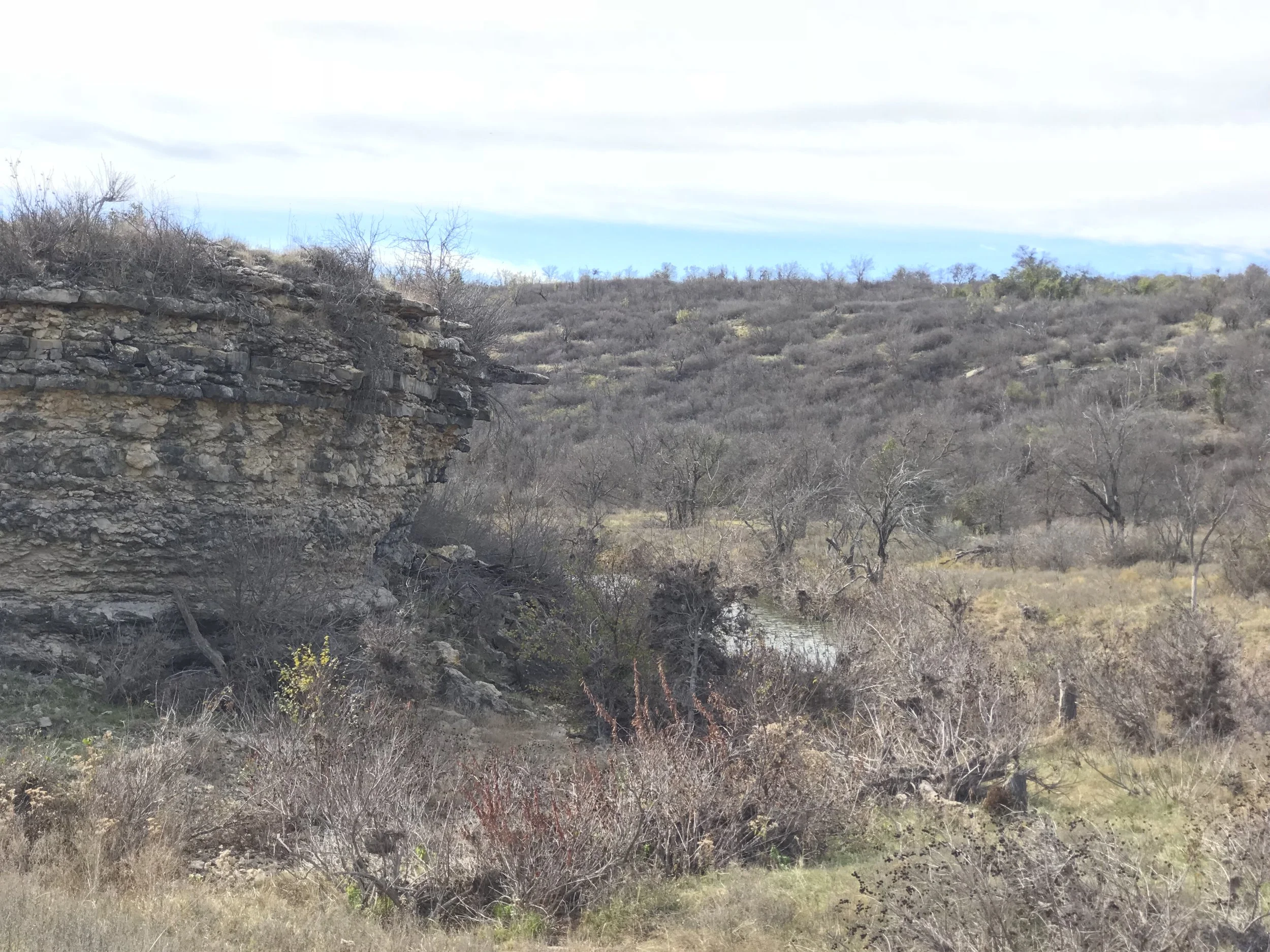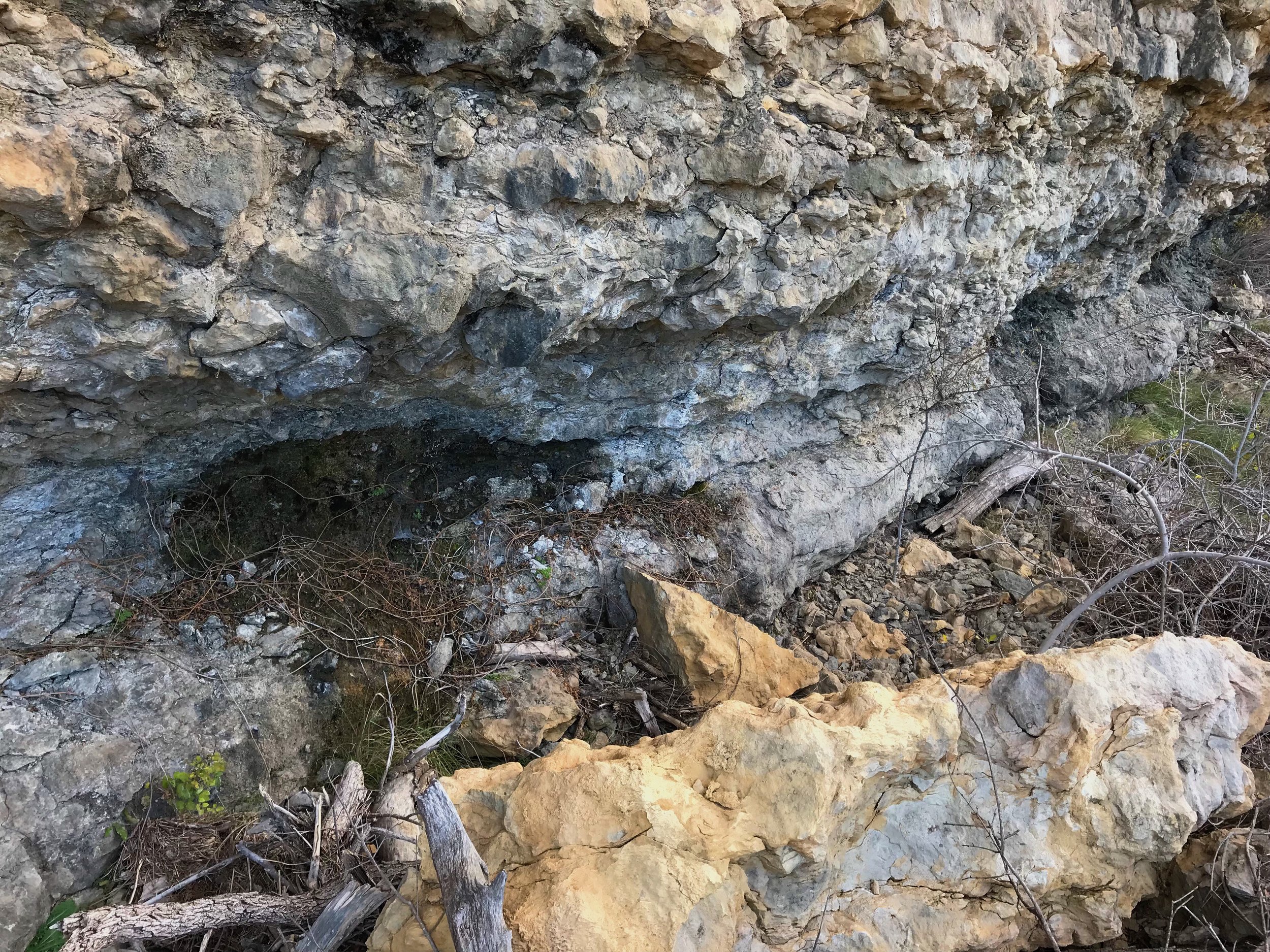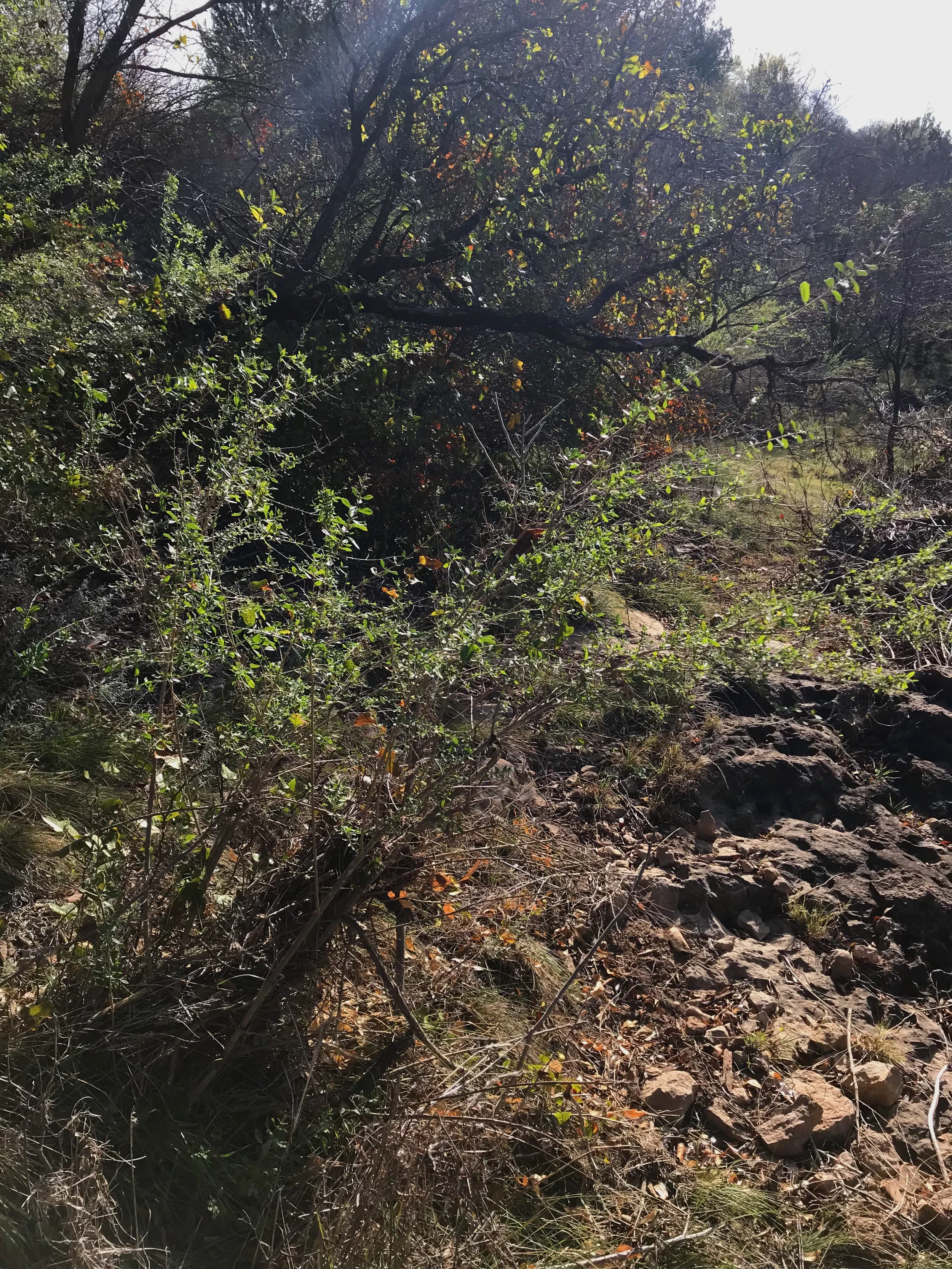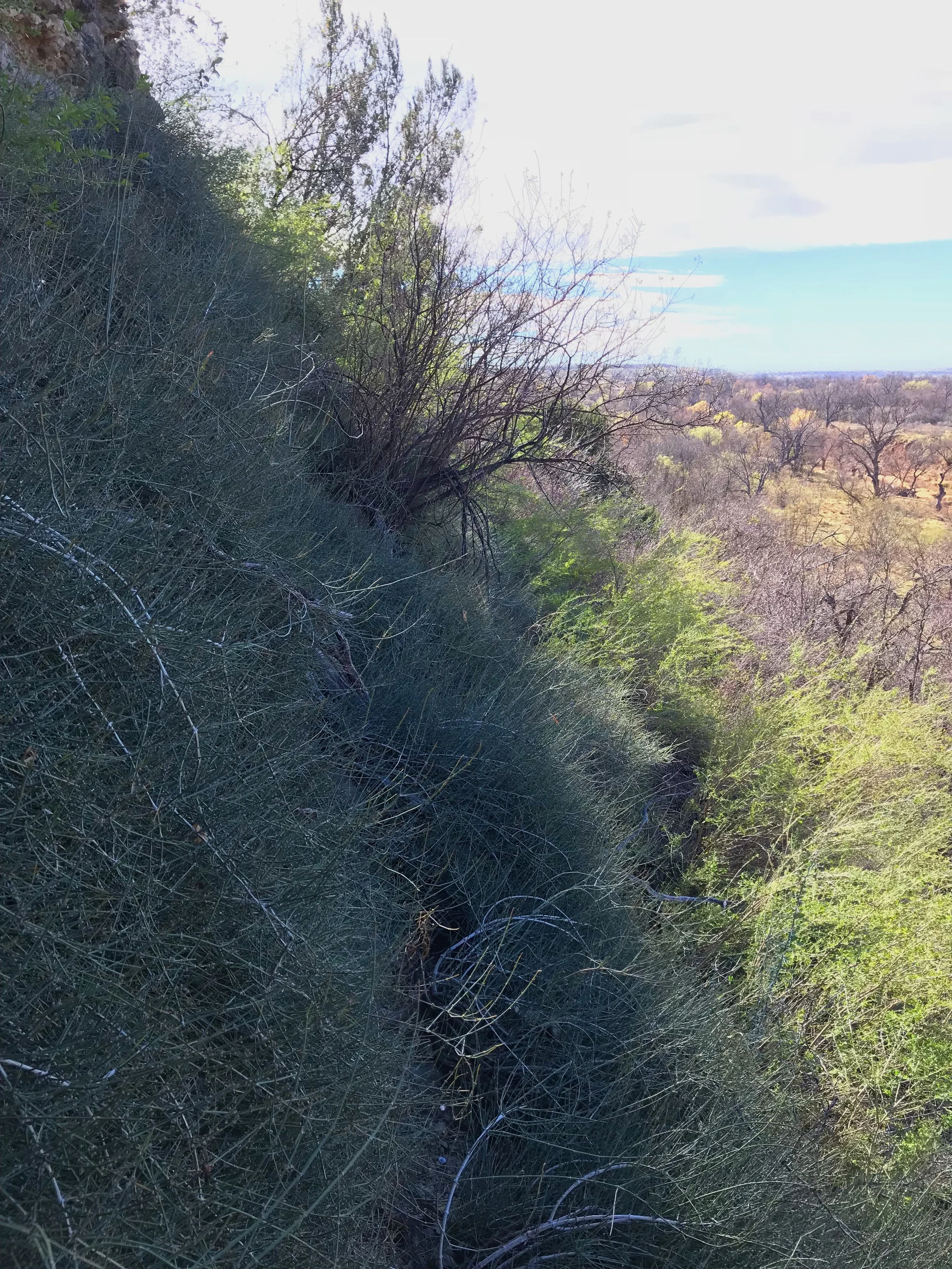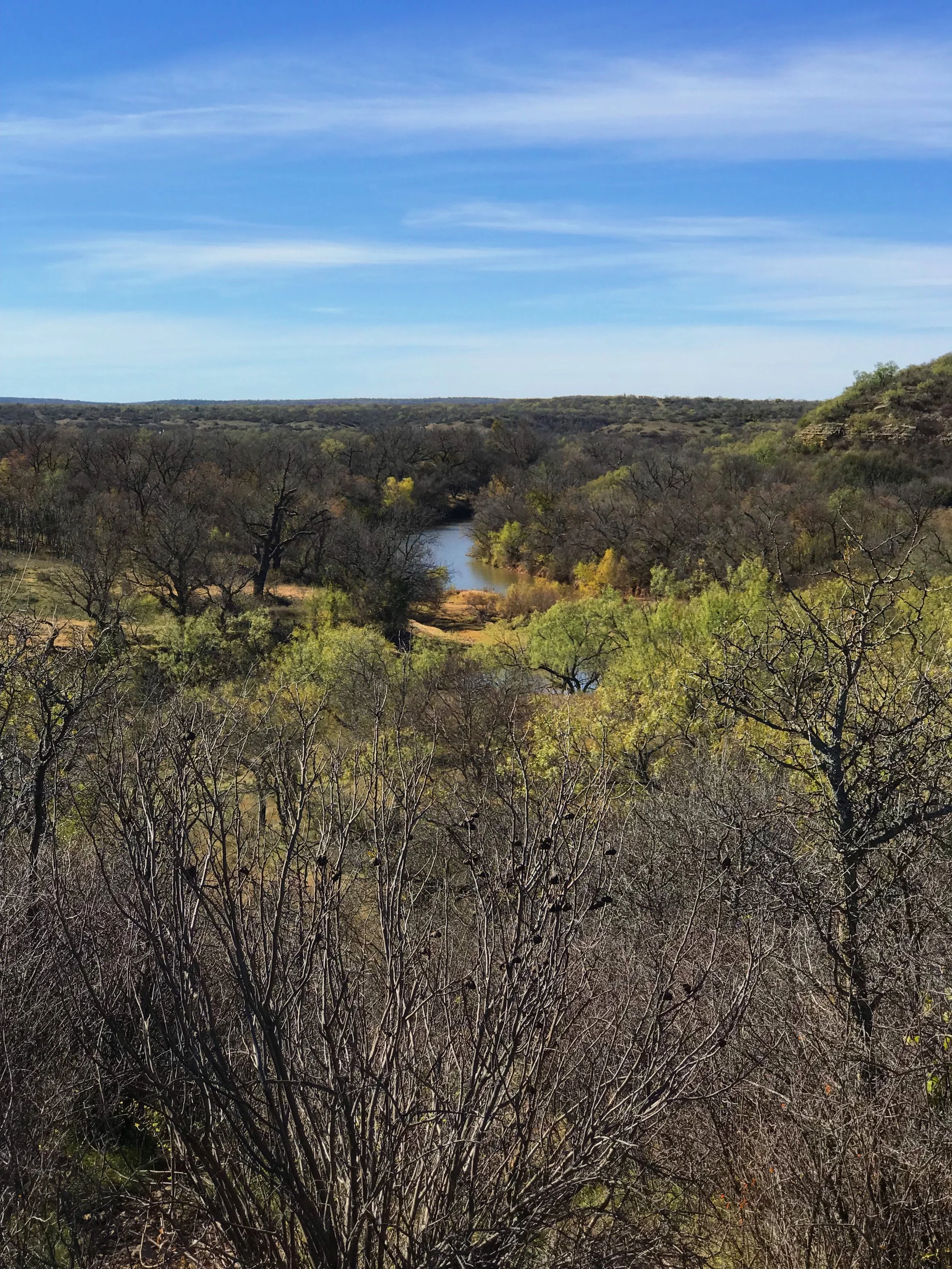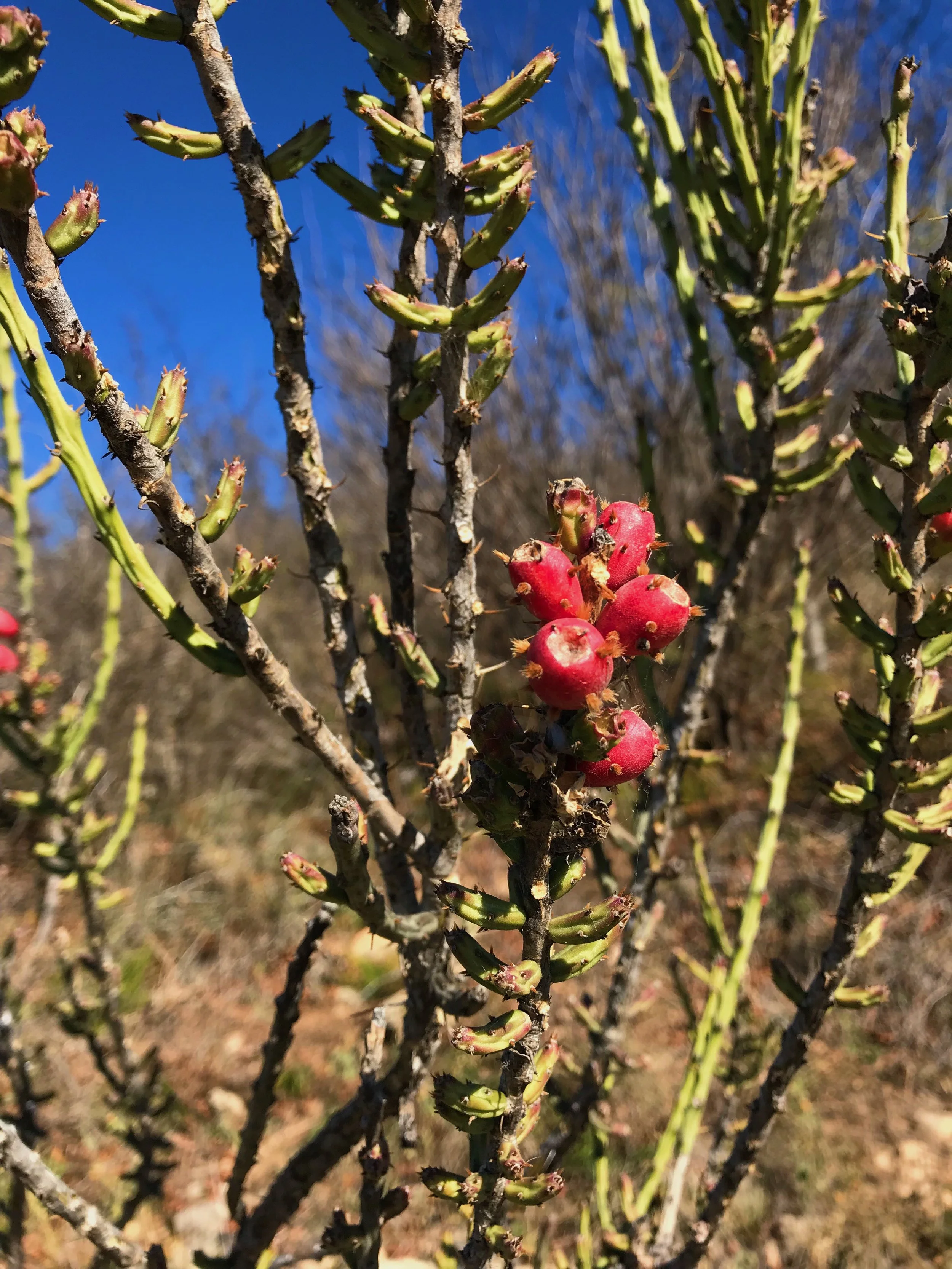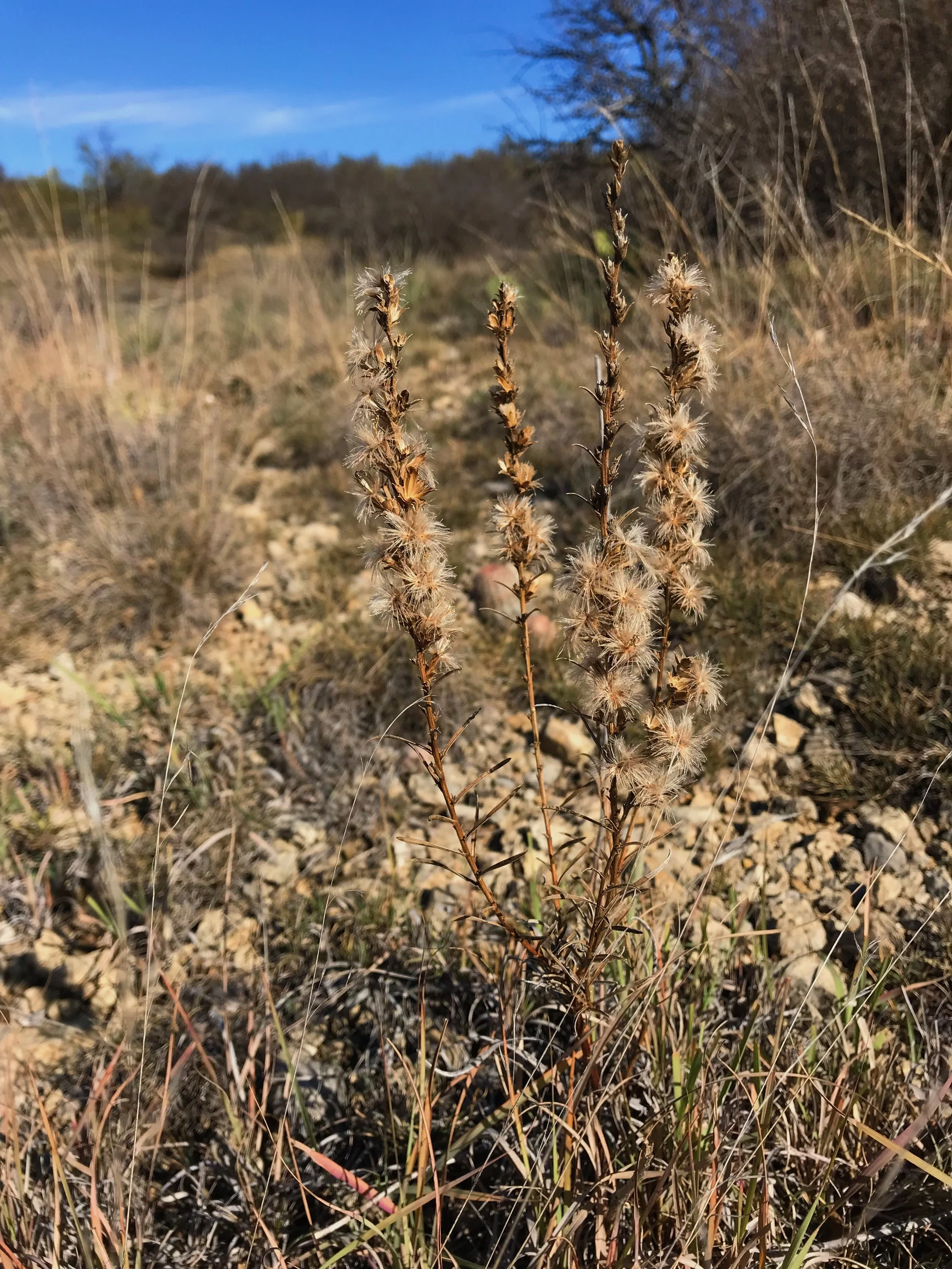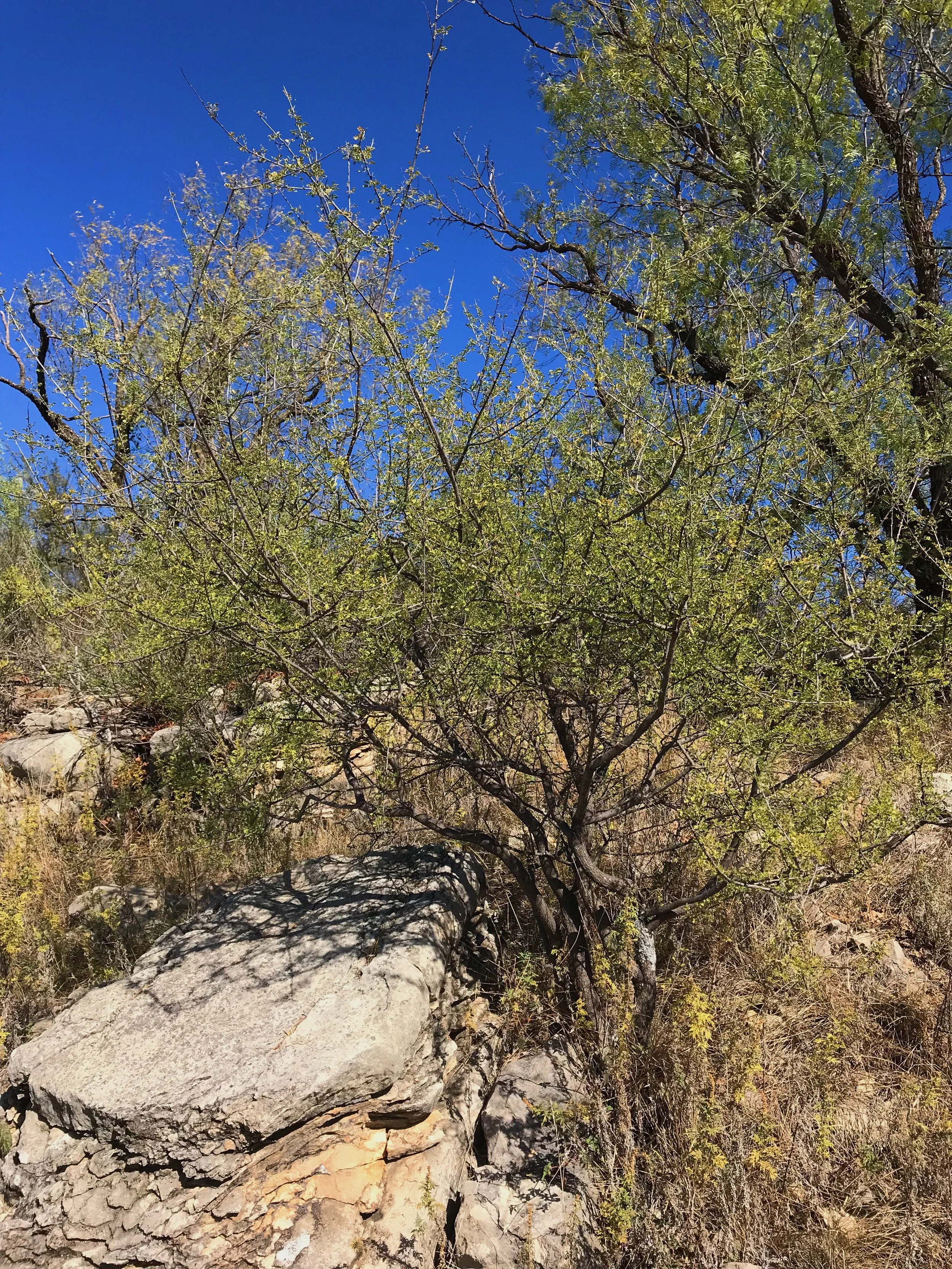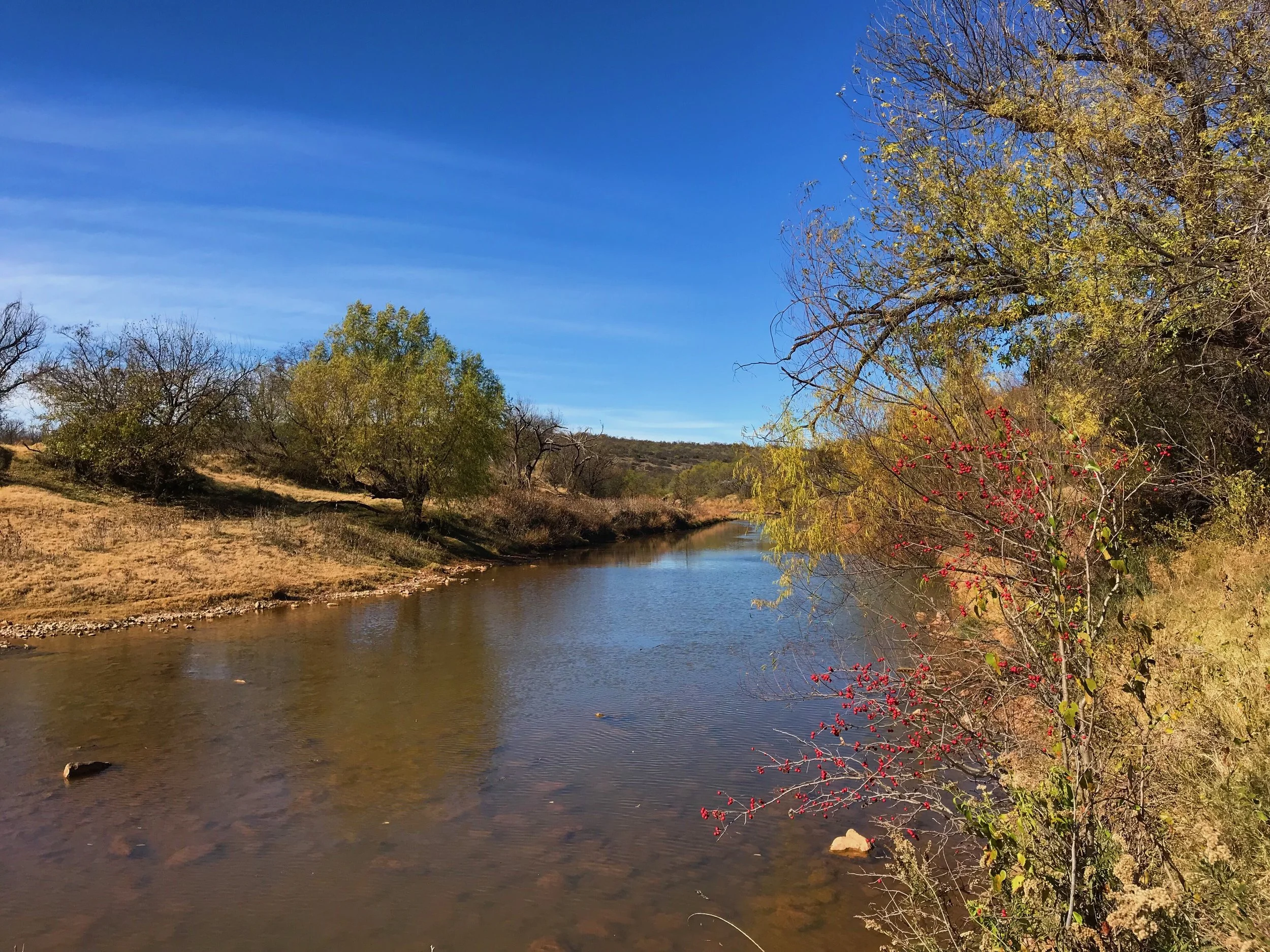Ranger Creek
I recently explored another topographically-interesting area of southwestern Throckmorton County in north central Texas. Ranger Creek between the YL Ranch (where I explored last summer) and the Clear Fork of the Brazos River is a north to south, intermittent waterway that crosses limestone outcroppings. Starting near an oil well on the YL Ranch, I began my 3 mile trek south following Ranger Creek.
The area has already experienced a few light freezes, so most grasses are brown and dormant, and the trees are dropping leaves. The majority of Texas sees relatively no quick changes in elevation, and Throckmorton County is, generally, no exception. But the closer you get to the Clear Fork of the Brazos River, you find more exposed limestone and steeper slopes. Valleys will rise and fall 300 feet, the ridges lined with rock and dotted with low scrub.
I was particularly interested in this area for a couple of reasons. I knew that Ungnadia speciosa, Mexican buckeye, had been observed formally in the county but I had never seen it personally. The conditions along Ranger Creek are ideal habitat for the buckeye and I was determined to find it. I am also very curious of the history here. White settlers came to this area around the end of the Civil War after a series of forts were built to defend against Native Americans, and in particular, tribes of Comanches.
Map of Ranger Creek watershed
My first find along Ranger Creek was no real surprise since I had observed it nearby previously. Eustoma is one of Texas' most impressive and showy wildflowers. In this stage you can see it is just rosettes before it sends up a 12"-24" stalk with violet-colored, single-petaled blooms in the spring and summer.
Eustoma exaltatum ssp. russellianum, Texas bluebells
Eustoma exaltatum ssp. russellianum, Texas bluebells
Soapberry is a smaller native tree, growing usually under 30' tall. Its range is mostly concentrated in Texas and Oklahoma, but reaches from Florida to Arizona. Its most attractive feature are the translucent berries that appear in summer and fall. This tree is sometimes confused with the invasive Chinabery, Melia azedarach.
Sapindus saponaria var. drummondii, Western soapberry
Sapindus saponaria var. drummondii, Western soapberry
Sapindus saponaria var. drummondii, Western soapberry
Junipers, or "cedars" as they are commonly called, are most despised by land managers that have grazing properties. These trees do spread by seed readily, but in many conditions, like this one, there is not much opportunity for them to be successful.
Juniperus pinchotii, Redberry juniper
Juniperus pinchotii, Redberry juniper
Topography in this part of Texas is mostly uneventful but there are a few interesting highlights along waterways, like this limestone outcropping, a result of many years of erosion by Ranger Creek. I imagine this made a nice lookout for Native Americans for many generations.
Limestone bluff along Ranger Creek
Limestone bluff along Ranger Creek
Limestone bluff along Ranger Creek
Seep at the base of a limestone bluff along Ranger Creek
Ranger Creek
Just downstream from this outcropping is a century-old schoolhouse, said to have been built in 1910. A few modifications have been made since its instructional days, like the addition of a bathroom and a screened-in porch. It was locked when I went by but the original slate blackboards are still hanging on the walls.
School house along Ranger Creek built in 1910
Another relic of white establishment is this footprint of a stone house built of local limestone. All that is left are a few cornerstones and a pile of rubble that was once the hearth. It is said that this was a two room house, each room occupied by a couple. Two brothers married two sisters and they lived in the house while raising families. The house was built around the 1880s and was used for several decades.
Limestone cornerstones of early Reynolds house built in 1880s.
Limestone hearth of early Reynolds house built in 1880s.
This ridge across Ranger Creek from the old stone home was my next destination. Botanical interest is heightening here as the slopes become steeper and the creek gets deeper.
Limestone bluff along Ranger Creek
As I started up he slope, I noticed there were many clumps of bee brush growing here. This is a woody, deciduous shrub that blooms profusely in the spring, attracting all sorts of pollinators. The white blooms are also very sweetly-scented.
Aloysia gratissima, Bee brush
With the colder temperatures, many plants have foliage that changes color, a reaction to stress. This is pigeonberry, a shade-loving perennial that has pink blooms that give way to red berries, which are prized by birds. The leaves are usually much more green.
Rivina humilis, Pigeonberry
Rivina humilis, Pigeonberry
Mormon tea is a low-growing shrub that is usually found on well-drained, gravelly sites. Its growing range is nearly exclusively in Texas and northern Mexican states. The leaves are so small that they are nearly of no consequence. Ephedra is derived from this plant and it has long been used for medicinal purposes by Mexicans and Native Americans.
Ephedra antisyphilitica, Mormon tea
Ephedra antisyphilitica, Mormon tea
Ephedra antisyphilitica, Mormon tea
Juniperus pinchotii, Redberry juniper
After having a close encounter with a critter in the shallow hole below the juniper, I scaled the ridge and got a better view of my surroundings. The top of the hill has very shallow soil with few shrubs. Below you can see Arkansas yucca amongst the grasses.
Yucca arkansana, Arkansas yucca
Along with yuccas, the area was dotted with lace cactus. These barrel cacti put on fuchsia-colored blooms in the spring and summer, but are easily camouflaged by the surrounding rocks during most of the year. There were so many that I had to pay special attention to not step on any smaller ones.
Echinocereus reichenbachii, Lace cactus
Echinocereus reichenbachii, Lace cactus
Echinocereus reichenbachii, Lace cactus
Echinocereus reichenbachii, Lace cactus
Echinocereus reichenbachii, Lace cactus
Along with the plants, there were many fossils to observe. Some appeared to have impressions of shells and coral, harkening back to the days when this area was covered in salt water.
Fossils along the ridge
Fossils along the ridge
One more ridge down Ranger Creek, I came across the plant species that spurred the hunt. Below, you can see the clumps of buckeyes dotting the bare spots between the brush in the creek bottom and the shade trees along the top of the ridge. In the spring, these buckeyes are covered in pink blooms that are sweetly-scented. These give way to seed pods that hold 4 black seeds about the size of a dime. In warmer climates and with a bit more moisture, you will see them grow upwards of 10'-15' tall, but most of these specimens were shorter than 6' in height. I crossed back over Ranger Creek and moved closer for inspection.
Limestone ridge with Ungnadia speciosa, Mexican buckeye
Ungnadia speciosa, Mexican buckeye
Ungnadia speciosa, Mexican buckeye
Ungnadia speciosa, Mexican buckeye
In view from the ridge you can see where Ranger Creek meets the Clear Fork of the Brazos River. The Brazos makes a large curve from south to north and then back south here called Reynolds Bend. Around the time of the Civil War, forts were built along west Texas to help defend white settlers from hostile Native Americans. In 1856 Camp Cooper was established just a few miles down the Brazos from this spot, along with the Comanche Indian Reservation. This allowed the surrounding area to be settled by whites, including the Reynolds family. Their homestead still lies in the interior of this bend.
Ungnadia speciosa, Mexican buckeye with the Clear Fork of the Brazos River in the background
Ungnadia speciosa, Mexican buckeye with the Clear Fork of the Brazos River and Reynolds Bend in the background
Clear Fork of the Brazos River
This species of cholla called Christmas cactus is very thinly-branched with small, red fruit. You can find it throughout most of Texas, but I was very interested to get a photo opportunity with Mexican buckeye and Arkansas yucca.
From L to R: Ungnadia speciosa, Mexican buckeye :: Yucca arkansana, Arkansas yucca :: Cylindropuntia leptocaulis, Christmas cactus
Cylindropuntia leptocaulis, Christmas cactus
Blackfoot daisy is not a real interesting find but I'm happy to see that it hasn't gone dormant yet.
Melampodium leucanthum, Blackfoot daisy
While liatris has already gone dormant, I do like the feathery seeds that are left behind, which has led to another common name of gayfeather. These blooms come in shades of purple. Liatris has a deep taproot that allows it to withstand particularly dry conditions which are common on these limestone plateaus.
Liatris punctata, Gayfeather
Fragrant mimosa was another surprising find for me as I don't ever remember observing it this far east. In the spring, this thorny shrub will have a profusion of pale pink flowers that resemble puffballs. It is a wonderful host plant for pollinators.
Mimosa borealis, Fragrant mimosa
Mimosa borealis, Fragrant mimosa
Mimosa borealis, Fragrant mimosa
Penstemon species are special to me and one of my favorite wildflowers. This species is found throughout north Texas. In the spring, the blooms will be white with purple veins on the interior of its throat.
Penstemon cobaea, Prairie penstemon
Penstemon cobaea, Prairie penstemon
Penstemon cobaea, Prairie penstemon seeds
For the standards of the area, this is a very large limestone cliff face. It's obvious that water runs here after heavy rains. Because of its close proximity to Ranger Creek and the Clear Fork of the Brazos, I inspected to see if there were any pictographs or petroglyphs as this area has likely been occupied for thousands of years. I did find a few interesting shapes, but it is most likely some sort of fungal growth.
Limestone bluff with potential petroglyphs
Limestone bluff with potential petroglyphs
Limestone bluff with potential petroglyphs
Down from the top of the ridge, I made my way to the river bottom where I found this possumhaw holly laden with red berries. This is the only holly species you will find in the county, and this one is occurring on its very far western edge of habitat. You will also see a few pecan trees in the background, the official state tree of Texas.
Ilex decidua, Possumhaw holly
Along the banks of the Brazos there were several stands of frog fruit growing in the red sand. In the verbena family, these tough perennials prefer occasional moisture, making the river bank an ideal habitat.
Phyla nodiflora, Frog fruit
Boneset is another perennial that prefers occasional moisture. This plant is a wonderful species for pollinators and can grow over 6 feet tall.
Eupatorium serotinum, Late-flowering boneset
Clear Fork of the Brazos River
I considered this hike a great success. I found the buckeyes I was in search for, but also got to experience a lot of the history of a more topographically-interesting area of north and west Texas. I do plan to return in the spring to see a lot of these species blooming.
Clear Fork of the Brazos River




